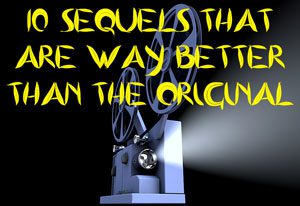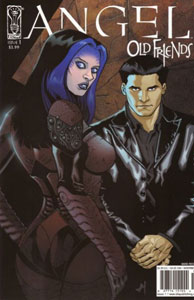“Old Friends” (November 2005-March 2006), the second IDW “Angel” comic series where Jeff Mariotte is tasked with introducing us to “Season 6” – apparently without being allowed to address the cliffhanger at the end of Season 5 – is marginally more satisfying than “The Curse.” We get solid information about the fates of characters other than Angel (who went solo in “The Curse”). We now know Spike, Gunn, Lorne and Illyria survived the demon incursion, although Gunn now sports an eye patch – unlike Xander’s, his injury is temporary, he says.
I don’t necessarily mind that the story leapfrogs the whole demon war. I’m not sure I even want to see that in comic-book form anyway. And context clues in “The Curse” and “Old Friends” at least allow us to understand this new reality: Humanity has survived, and while this is not quite a post-apocalytpic wasteland, civilization has been knocked back a peg.
The sparseness of the storytelling in the five-issue “Old Friends” is paired with sparse art of the Los Angeles streets by David Messina. Or maybe it just seems sparse because Mariotte’s story is so thin – surprisingly thin considering how many good “Angel” novels he wrote. At any rate, on both my original reading and this re-read, I was struck by how much less vibrant these IDW comics seem compared to the character- and story-rich Season 5 and even the “Angel” Dark Horse comics (which were set in Seasons 1 and 2).
Looking closer at Messina’s work, “sparse” is a little unfair. He shows us the brick buildings bordering alleyways in solid establishing shots, then zooms in on characters’ faces (which are always excellent likenesses) for the action, eschewing backgrounds in those panels. While these are color comics, black is so much the primary color that a reader feels like Los Angeles is in perpetual night – even more than one would expect from “Angel.” I feel like the sun was lost in the demon war.
As for “Old Friends’ ” story: Doppelgangers of the main cast — plus the late Cordelia, Wesley and Fred – harass our heroes, who quickly dispatch them each time. After repetitive fights – which include decent banter such as Spike noting that Illyria’s conversational skills haven’t changed – the gang finds that Wolfram & Hart’s Dr. Sparrow (from Season 5) has created these physically realistic but short-lived copies. Sparrow is irked that he’s jobless now that W&H has been wiped out, so he spends his free time doing mad-science-ing just for kicks.
IDW’s storyline has a big ace in the hole at this point: Illyria. Her arc was only partly told in Season 5, which ended amid the early steps of her villain-turned-hero journey. When she appears in “Old Friends” in all her blue-tinged glory, the story gets a spark of life partly because she is so visually striking.
By the time we reach the end of the padded “Old Friends,” Angel, Spike and Gunn (Illyria is out and about somewhere) resolve to continue to fight the good fight, helping the helpless, as has been the theme of “Angel” from the beginning.

But I lament how much has been lost in the transition from TV to comics, from Season 5 to “Season 6.” L.A. seems thinly populated and less of a living and breathing city than before the cliffhanger, and our team apparently has no homes or home office.
Part of the sense of loss comes from the TV show’s choice to kill off Wesley in “Not Fade Away” (5.22), which works OK for a finale, but not so much for an ongoing story. Arguably, lamenting Wesley’s absence is how I’m supposed to feel, but I wish his loss was more directly addressed by Mariotte. Instead, we get an ephemeral sense that too much of the old gang has been whittled away, with Wes being the final straw.
It could make for a good yarn to see four champions try to do their thing without a strategy man at their core – a team of all-stars without a coach. Regardless of the thematic direction going forward, more world-rebuilding and team-rebuilding is needed. The engine of IDW’s “Angel” isn’t purring yet.
Click here for an index of all of John’s “Buffy” and “Angel” reviews.

